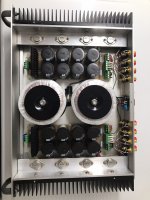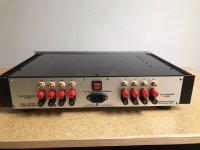Your problem: you do confuse looking-measurement and hearing-measurement;-)show me the data....why do i feel like Cuba Gooding Jr. right now????
You do ask for datas of looking-measurement, which, however, does not represent hearing-measurement and does not even begin to recreate it.
You continue to build amplifiers for lawn mowers or elevators or wheelchairs..., please;-) This is a forum for audio electronics, hearing-measurement;-)
Where do you pull that ridiculous nonsense from?You continue to build amplifiers for lawn mowers or elevators or wheelchairs..., please;-) This is a forum for audio electronics, hearing-measurement;-)
You are not even creative, just boring insulting.
Although the type of insulation disk does effect the capacitance from the transistor's collector to the heat sink/chassis, this would be negligible in any reasonably designed amplifier where attention had been paid to proper power supply bypassing and grounding techniques.Various insulation discs for transistors have different influence on the sound.
Hi,
I think commercial Amplifier sellers are not allowed to run touchable parts above 50 (?) degrees. So they have to be big and - probably most important - expensive.
If you have the heatsink internal you can run it at 100 degrees if you isolate it from the case. And no customer gets panic.
Heatsinks outside are much more efficient, but for me its a pain to carry such amplifiers around. So if I need not to get rid of a lot of heat I prefer heatsink internal. But since I am a DIY I built them with a wide slot at the bottom to ge a good ventilation directly to the fins.
Regards Jean-Claude
I think commercial Amplifier sellers are not allowed to run touchable parts above 50 (?) degrees. So they have to be big and - probably most important - expensive.
If you have the heatsink internal you can run it at 100 degrees if you isolate it from the case. And no customer gets panic.
Heatsinks outside are much more efficient, but for me its a pain to carry such amplifiers around. So if I need not to get rid of a lot of heat I prefer heatsink internal. But since I am a DIY I built them with a wide slot at the bottom to ge a good ventilation directly to the fins.
Regards Jean-Claude
I had to Google that 😆show me the data....why do i feel like Cuba Gooding Jr. right now????
Warm air elevates, most people learn that in kindergarten. More easy with vertical fins 😊
Black surface radiates! heat better than silver or other color... High school physics 😊
Internal heatsinks will heat up their surroundings by radiation and all those black caps will receive that, get a fever and die from dehydration...
Most manufacturers mount the frontend/driver boards to the external heatsink, so everything on that boards gets hot if the heatsink does.
Heatsinks should be external, black, with vertical wide spaced fins, not be obstructed anywhere.
Black surface radiates! heat better than silver or other color... High school physics 😊
Internal heatsinks will heat up their surroundings by radiation and all those black caps will receive that, get a fever and die from dehydration...
Most manufacturers mount the frontend/driver boards to the external heatsink, so everything on that boards gets hot if the heatsink does.
Heatsinks should be external, black, with vertical wide spaced fins, not be obstructed anywhere.
I tend to use old pc cases for my amps.
Heatsink is inside but I use fans on front and back of case to get good air flow.
In theory heat sink on outside is better as heat isnt building up inside case as much.
With heat sink outside you can use a smaller case.
Heatsink is inside but I use fans on front and back of case to get good air flow.
In theory heat sink on outside is better as heat isnt building up inside case as much.
With heat sink outside you can use a smaller case.
I've seen middle ground. My apt has them internal sort of. They are mounted on the sides and the bottom has large vents on the sides and the top/sides of the case is perforated. Runs very cool. It is easier to handle than my hafler or my amber which both have sinks external. While not exactly sharp edges, the sinks on those amps make them a little harder to pick up. And of course even with external sinks the hafler runs much hotter than the apt. The amber like the apt runs quite cool. I like WintrMute2's solution. Well ventilated and yet easily moved. And being able to pickup an amp given their weight is something to consider. I've also got an outlaw 755 (200x5) that weighs a ton, well ok not quite, I think 100lbs.
I build my own chassis so I prefer external heat sinks because they become the structural sides, as the OP mentioned in his first post. This really simplifies the construction and thermally functions very well. Here's a few photos of a recent 8 ch amp project with a standard 19", 2 RU sized chassis. The front, rear and base plate are 1/8" aluminum salvaged from an old Mac G5 computer case. Top is smoked lexan. Materials were cut on a regular table saw including the heat sinks. Beyond that, drilling and tapping is all that's needed. Currently working on amp #3 using the same style since it's easy, looks OK and works well.
Attachments
well i perhaps may be reliving my "glory days" as a touring soundman but external heat sinks didn't concern me as they usually lived in a rack/road case.... and cooling became the domain of rack design in order to accommodate having 4 Bryston 3B's in one rack and for those of you moaning about portability and ease of carry it should only be a concern if your trying to make your system portable....at home i would gladly live with a chirstmas tree like structure (sorry likely a seasonal influence!!) that was untenable to move so long as it provided me with an edge in performance characteristics... forced air or not....
and to anyone out there recycling or re-using to the ends of thermal management...kudos...
and to anyone out there recycling or re-using to the ends of thermal management...kudos...
- Home
- Amplifiers
- Solid State
- Internal vs External Heat-Sinks


